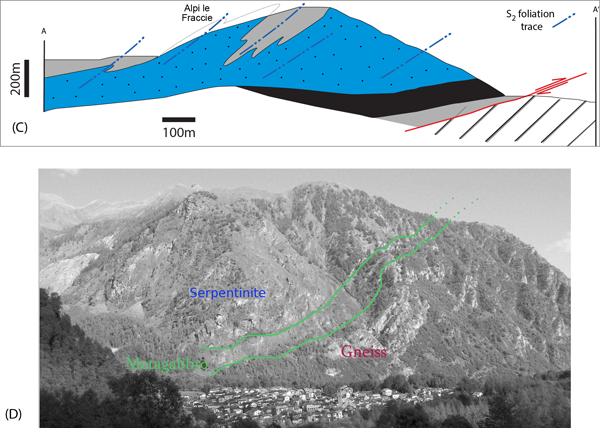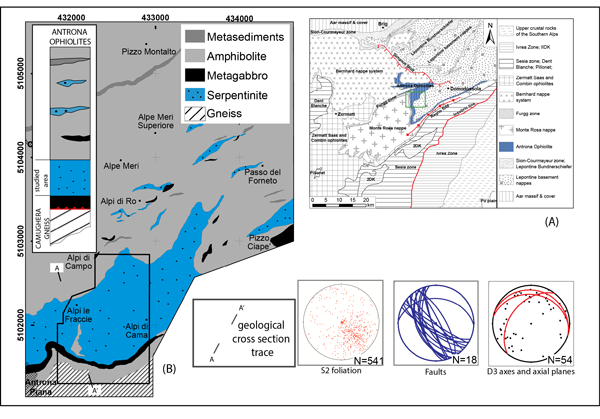Mesostructure of the Antrona ultramafic rocks
The ultramafic portion of the Antrona ophiolite is exposed near the village of Antronapiana where it forms a ca. 35 km2 wide massif (Fig. 1). The ultramafic rocks underlie amphibolites and metasediments, thus constituting a sole for the volcanic and cover portion of the ophiolite sequence. In their marginal parts, the ultramafic rocks are in contact with flaser metagabbro grading to mylonitic amphibolite near the main tectonic contact with the Middle Penninic Camughera-Moncucco unit, here consisting of orthogneiss (Fig. 1).
Figure 1. Mesostructure of the Antrona ultramafic rocks

A) Tectonic map of the North-eastern Pennine Alps with location of the Antrona ophiolite; B) Simplified geologic map of the Antrona ophiolite with location of the geological cross section; C) Geological cross section through the Antrona ophiolite and the underlying Camughera gneiss; D) Panoramic view of the Antrona ophiolite – Camughera gneiss contact. Stereographic plots of S2 foliation, faults, and D3 fold axes are reported (see text). (Modified after Tartarotti et al., 2011).
The ultramafic rocks are represented by serpentinite, dunite, amphibole-rich rocks, and chloriteschist. Dunite occurs as dm-thick layers or pods parallel to the serpentinite foliation. The amphibole-rich rocks form dm-thick and few meters-long layers concordant with the serpentinite foliation (see Fig. 2). The contact between these layers and serpentinite is marked by chloriteschist. Chloriteschists also occur as isolated layers within the serpentinite or they are associated to amphibole+chlorite-rich layers. The main ultramafic rock is indeed represented by serpentinite, commonly characterized by a weak foliation and fine grainsize. Mylonitic serpentinites occur near the border of the ultramafic massif. Serpentinites include mm- to cm-sized layers of mafic/ultramafic rock. The following types of rocks interbedded within serpentinites were distinguished in the field: a) millimetric brownish ol+cpx-layers (Fig. 2a); b) millimetric boudins or lozenge-shaped cpx+amp±chl±mag-aggregate (Fig. 2b); c) centimetric white-to-greenish cpx-rich layers transposed within the serpentinite foliation (Fig. 2c).
The most pervasive foliations recognizable at the scale of the outcrops (S1 and S2) are developed in the entire ophiolitic section and are related to different stages of the Alpine evolution. In the ultramafic rocks, S2 is mainly defined by antigorite and magnetite; S1 is recorded by the ol+cpx-layers and cpx-rich layers infolded in the serpentinite and forming tight or isoclinal folds (mostly detectable under the microscope) within the S2 foliation (Figs. 2a and 2c). S1 foliation is attributed to D1 deformation. Isoclinal folding of S1 and development of the S2 foliation are ascribed to D2 deformation (Figs. 2a and 2c), which is also responsible for mylonitization of serpentinite near the border of the massif. S1 and S2 foliations are then overprinted by D3 deformation generating crenulation or chevron folds (Fig. 2e), commonly concentrated near the contact between serpentinites and harder mafic rocks. D3 folds do not develop axial plane foliation visible at the outcrop scale but concur to the high dispersion of S2 data (see Fig. 1). Late, brittle D4 deformation is characterized by diffuse S-C type structures and fractures overprinting all previous structures, commonly generating lozenge-shaped rock volumes at all scales especially in serpentinites and in calcschists (Fig. 2f).
Figure 2. Main mesostructural features of the Antrona ophiolite.

A) to C): Main structures related to the D1 and D2 deformation phases. D) Amphibole-rich layer concordant with the serpentinite (S2) foliation). E) and F) refers to structures related to late D3 and D4 phases. Pictures on the right side show representative outcrops of structures described on the left. D = deformation; S = foliation.
